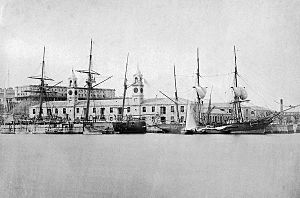HMS Viper (1865) facts for kids

A contemporary cut away diagram of Viper
|
|
Quick facts for kids History |
|
|---|---|
| Name | HMS Viper |
| Ordered | 22 March 1864 |
| Builder | J & W Dudgeon, Cubitt Town, London |
| Cost | £51,127 |
| Laid down | 1864 |
| Launched | 21 December 1865 |
| Commissioned | 1866 |
| Fate |
|
| General characteristics | |
| Displacement | 1,228 tons |
| Tons burthen | 737 bm |
| Length | 160 ft (49 m) pp |
| Beam | 32 ft (9.8 m) |
| Draught | 11 ft (3.4 m) |
| Installed power | 696 ihp (519 kW) |
| Propulsion |
|
| Sail plan | Barquentine rig (removed 1873) |
| Speed | 9.5 kn (17.6 km/h) |
| Complement | 80 |
| Armament | |
| Armour | 4.5 in (11 cm) iron belt and bulkheads with 10 in (25 cm) of teak backing |
HMS Viper was a special kind of gunboat built from iron and covered in armor. She was the only ship of her type. She was also the fourteenth ship in the Royal Navy to be named Viper.
Contents
Ship Design and Features
The Admiralty designed Viper as an experimental ship. She was like a "half-sister" to two other ships, Vixen and Waterwitch. All three were built to test new ideas. While Viper and Vixen used two propellers, Waterwitch had a unique water-pump system. Vixen was very similar to Viper, but she was made from a mix of materials.
Hull Construction
Viper was an armored gunboat with a special "breastwork" design. Her body, or hull, was made of strong iron. This iron was backed by a thick layer of teak wood, about 10 inches (25 cm) thick. At the back of the ship, there were special openings. These allowed the propellers to be lifted out of the water. This helped the ship move better when it was only using its sails.
Engine and Speed
The ship had two steam engines, each with four cylinders. These engines powered her two propellers, which were 9 feet (2.7 meters) wide. Together, the engines produced 696 horsepower. This power allowed Viper to reach a top speed of 9.5 knots (about 17.6 km/h). Two large boilers provided the steam needed for the engines.
Sail Plan and Changes
Viper was originally built with a barquentine rig. This meant she had a specific setup of masts and sails. However, in 1873, all her masts, ropes, and other top-deck parts were removed. This happened because it was decided that Viper and Vixen would stay permanently in Bermuda.
Ship's Weapons
Viper carried two large 7-inch (17.8 cm) guns. These were muzzle-loading guns, meaning they were loaded from the front. She also had two smaller 20-pounder (9 kg) guns. These were breech-loading, which means they were loaded from the back. One of the 7-inch guns from either Viper or Vixen was displayed in St. George's, Bermuda, as recently as 1991.
Building the Ship
The order for Viper was placed with J & W Dudgeon in Cubitt Town, London, on March 22, 1864. Her construction began in the same year. She was officially launched into the water on December 21, 1865. Viper was then ready for testing in 1867. The total cost to build her was £51,127.
Ship's Service and Trials
Viper, Vixen, and Waterwitch took part in special tests. These trials happened in Stokes Bay in the Solent during the late 1860s. The ships were good at turning, but none of them could go faster than 9.5 knots (17.6 km/h). This was slower than other ships of the time, like Warrior, which could reach 14.5 knots (26.9 km/h).
Also, Vixen almost sank in the Irish Channel during a big storm in 1876. This showed that these ships were not very good for sailing in rough open seas. Because of this, Vixen and Viper were towed to Bermuda in 1868. The waters around Bermuda were better suited for steam-powered ships like them.
In July 1869, both Viper and Vixen helped move a large floating dock called Bermuda. They moved it from The Narrows to the dockyard. In 1873, all their masts and rigging were removed. This change might have helped Viper survive a strong hurricane in 1878. The hurricane caused serious damage to the floating dock and other parts of the dockyard.
What Happened to Viper
Viper was used for harbor duties starting in 1890. In 1901, she was changed into a vessel for carrying liquids, like a tank ship. Finally, in 1908, Viper was sold in Bermuda.


